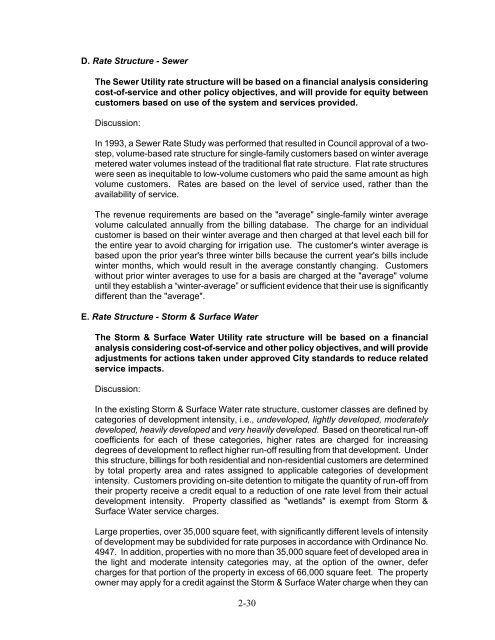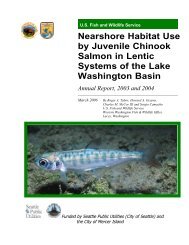2006 Water Comprehensive Plan - City of Bellevue
2006 Water Comprehensive Plan - City of Bellevue
2006 Water Comprehensive Plan - City of Bellevue
- No tags were found...
Create successful ePaper yourself
Turn your PDF publications into a flip-book with our unique Google optimized e-Paper software.
D. Rate Structure - SewerThe Sewer Utility rate structure will be based on a financial analysis consideringcost-<strong>of</strong>-service and other policy objectives, and will provide for equity betweencustomers based on use <strong>of</strong> the system and services provided.Discussion:In 1993, a Sewer Rate Study was performed that resulted in Council approval <strong>of</strong> a twostep,volume-based rate structure for single-family customers based on winter averagemetered water volumes instead <strong>of</strong> the traditional flat rate structure. Flat rate structureswere seen as inequitable to low-volume customers who paid the same amount as highvolume customers. Rates are based on the level <strong>of</strong> service used, rather than theavailability <strong>of</strong> service.The revenue requirements are based on the "average" single-family winter averagevolume calculated annually from the billing database. The charge for an individualcustomer is based on their winter average and then charged at that level each bill forthe entire year to avoid charging for irrigation use. The customer's winter average isbased upon the prior year's three winter bills because the current year's bills includewinter months, which would result in the average constantly changing. Customerswithout prior winter averages to use for a basis are charged at the "average" volumeuntil they establish a “winter-average” or sufficient evidence that their use is significantlydifferent than the "average".E. Rate Structure - Storm & Surface <strong>Water</strong>The Storm & Surface <strong>Water</strong> Utility rate structure will be based on a financialanalysis considering cost-<strong>of</strong>-service and other policy objectives, and will provideadjustments for actions taken under approved <strong>City</strong> standards to reduce relatedservice impacts.Discussion:In the existing Storm & Surface <strong>Water</strong> rate structure, customer classes are defined bycategories <strong>of</strong> development intensity, i.e., undeveloped, lightly developed, moderatelydeveloped, heavily developed and very heavily developed. Based on theoretical run-<strong>of</strong>fcoefficients for each <strong>of</strong> these categories, higher rates are charged for increasingdegrees <strong>of</strong> development to reflect higher run-<strong>of</strong>f resulting from that development. Underthis structure, billings for both residential and non-residential customers are determinedby total property area and rates assigned to applicable categories <strong>of</strong> developmentintensity. Customers providing on-site detention to mitigate the quantity <strong>of</strong> run-<strong>of</strong>f fromtheir property receive a credit equal to a reduction <strong>of</strong> one rate level from their actualdevelopment intensity. Property classified as "wetlands" is exempt from Storm &Surface <strong>Water</strong> service charges.Large properties, over 35,000 square feet, with significantly different levels <strong>of</strong> intensity<strong>of</strong> development may be subdivided for rate purposes in accordance with Ordinance No.4947. In addition, properties with no more than 35,000 square feet <strong>of</strong> developed area inthe light and moderate intensity categories may, at the option <strong>of</strong> the owner, defercharges for that portion <strong>of</strong> the property in excess <strong>of</strong> 66,000 square feet. The propertyowner may apply for a credit against the Storm & Surface <strong>Water</strong> charge when they can2-30
















